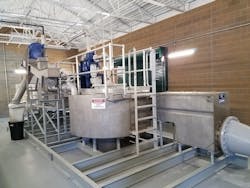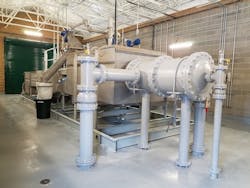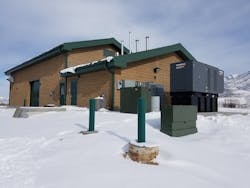About the author:
Chris French is a freelance writer on water, environment and renewable energy issues. French can be reached at [email protected].
The need to upgrade an aging lagoon system in Utah presented a growing community with an ideal opening to prepare its wastewater treatment plant for the future.
Pioneers settled and built Morgan City in 1868 approximately 50 miles northeast of Salt Lake City. The city’s four hard-working lagoons, which were created a century later, sought some respite in 2015 when they went septic. Morgan City had already been looking at designs for mechanical treatment systems prior to a dredging operation that saw more than 7 million gal of sludge pumped out of the laden lagoons.
“Naturally, we needed to comply with existing regulations”, said Jamie Grandpre, senior water and wastewater operator for Morgan City. “But, we also wanted to accommodate anticipated growth. This included compliance with the Phosphorus Rule, which was enacted by Utah Division of Water Quality (DWQ) in 2015.”
The Phosphorus Rule implements technology-based phosphorus effluent limits (TBPEL) for mechanical treatment facilities (total phosphorus less than 1 mg/L) and a nutrient load cap for discharging lagoons.
“We anticipate that our lagoons will exceed their phosphorus load in approximately five years, so when we were weighing up the options for mechanical treatment systems, we decided to work with J-U-B Engineers to move forward with a phased solution,” Grandpre, who has worked at the Morgan City treatment plant for more than decade, said.
As well as helping the 450-by-250-ft lagoons maintain compliance for the Utah Pollutant Discharge Elimination System (UPDES) permit, Morgan City also prepared for a future Phase 2 nutrient removal project. All improvements implemented in Phase 1 are set to be utilized in Phase 2.
“We agreed that we needed a long-lasting mechanical fine screen and grit removal system, so [we] joined forces in doing our homework and visiting other wastewater treatment facilities in Utah to speak to operators,” said Gary Vance, project engineer at J-U-B. “Jamie is one in a team of just three at Morgan City, so they have a huge responsibility and workload in looking after the wastewater as well as the water supply. Finding reliable, low-maintenance equipment that can truly stand the test of time is a must.”
Grandpre said he and his team had “heard some horror stories” about downtimes for upgrades and what happens when a backup is not put in place. Seeking a manufacturer with assurances to address these main concerns were high on his list of priorities, which narrowed the field of bidders. Ultimately, the lowest bid did not win.
The system procured by the city and assigned to the contractor for installation was a stainless-steel, corrosion-resistant, complete headworks package from Lakeside Equipment Corp. of Illinois via its representative in Utah, Goble Sampson.
This headworks packaged system (H-PAC) combined the Lakeside 6-mm Raptor mechanical fine screen with a bypass bar rack, as well as a SpiraGrit Vortex Grit Chamber in an elevated pre-engineered headworks system to reduce engineering costs. The system came with tanks for the screen and grit removal, as well as platforms and a trough to connect the two.
The headworks was oversized to accommodate a peak hour flow of 4 mgd, which exceeds the anticipated 20-year peak hour flow rate of 1.97 mgd. Two lift stations feed the headworks, each with two pumps. The design basis for this higher flow rate was based on the need to accommodate an absolute worst-case scenario where all four pumps would need to operate simultaneously. This is highly unlikely without severe flooding. Generally, the flows are expected to be less than 4 mgd.
Lift-station pumps at the city’s New Island Road discharge 700 gpm, while the existing Northwest lift-station pumps discharge 632 gpm. Lower flows and less frequent cycling are set to extend the operational life of the headworks equipment. In addition, the added cost to accommodate the higher flow rate of 4 mgd was minimal.
The temperature-controlled headworks and administration building, which provides protection against the elements, includes the screening and grit removal room, a storage room, the motor control center (sized for potential future mechanical facility including conduit stubs), an office and control room, a laboratory (sized for potential future mechanical facility), a bathroom, and mechanical and janitor room.
Since its installation, the Lakeside Raptor fine screen has removed inorganic solids that would otherwise head straight to Morgan City’s lagoons. The screen’s removal efficiency and low head-loss is achieved with an inclined cylindrical screenings basket design with varied screen bar heights. Its rotating rake teeth penetrate the screen bars to remove captured debris and prevent grease from blinding or plugging the screenings basket. Captured screenings are compacted, dewatered and washed free of most organics to approximately 40% solids. Volume is reduced by 50% and weight by 67%, thereby reducing disposal cost.
Operating over a range of daily flow rates, the SpiraGrit Vortex Removal System removes inorganic grit from treatment plant influent in a mechanically induced vortex environment. Rotating paddles maintain the flow velocity in the vortex chamber, keeping organics in suspension while allowing heavier grit to settle to the chamber floor.
This settled grit is moved across the stationary floor plate toward the center opening and into the lower grit hopper. Then an air lift or recessed impeller pump removes it from the lower hopper into a grit classifier.
“We’ve really grown in the past year, and this investment has brought about a considerable positive change for the plant,” Grandpre said. “Collecting all the garbage and grit before it goes to the lagoons has made them so much cleaner. We now have more capacity, whereas before you could see the build-up of scum in the corners.”
After installing the headworks equipment, Grandpre said he and his team could not believe how much grit was being collected, particularly in relation to small-scale manufacturing facilities in a nearby industrial park. All that grit previously would have entered the lagoons, and it made the utility recognize other contributors to the grit issue.
“Upstream we have a dairy, which due to the washing down of their floors straight to sewer, was, upon investigation, causing us a major issue. We also were receiving silage, which was far worse than just normal grit, but now with such a strong and reliable screen and grit removal system, the negative impact on the plant has been solved.”
The lagoon headaches have been mitigated with the new equipment he said, adding the ease of maintenance also has become a bonus.
About the Author
Chris French
Chris French is a freelance writer on water, environment and renewable energy issues. French can be reached at [email protected].


